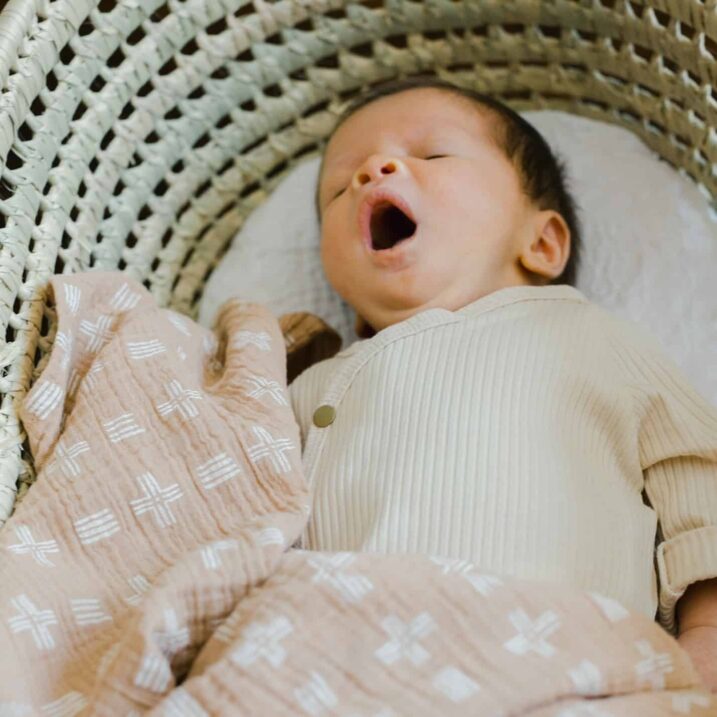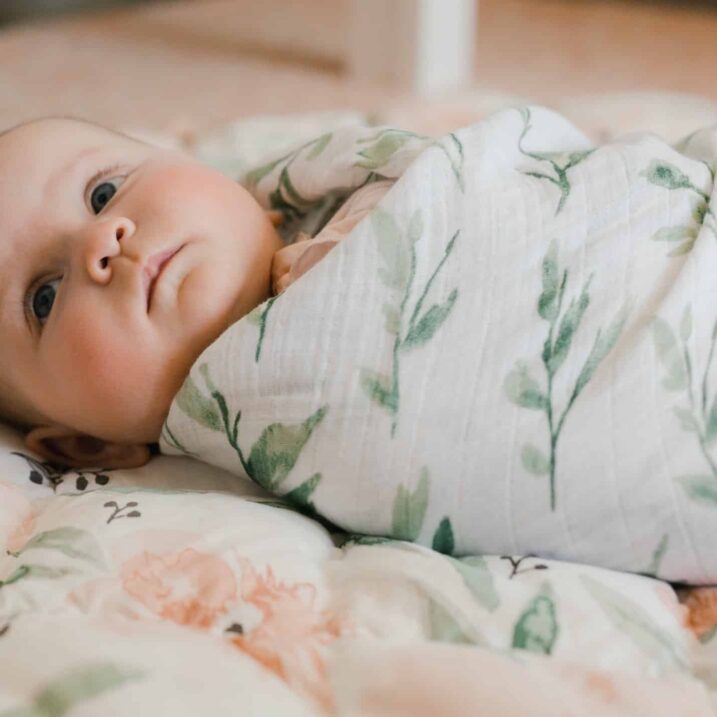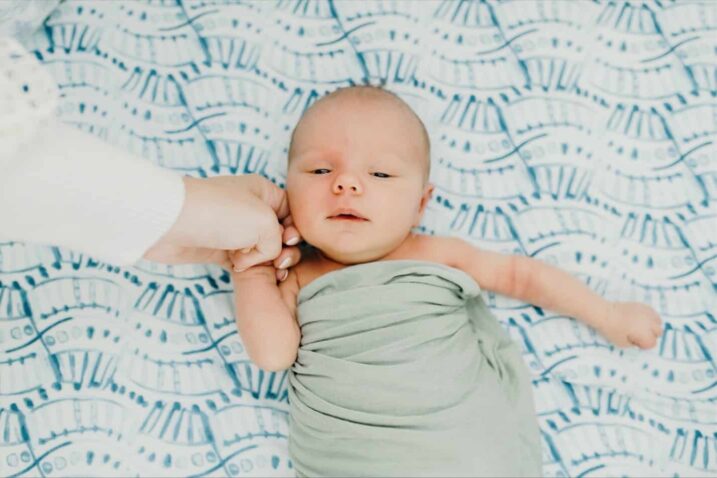Kids’ safety is always a parents’ number one priority. During the awake time, it is easy to protect them, ensure their safety and happiness. But how about night time? How about daytime while sleeping? Is there anything you can do to make sure they are safe and are getting the rest they need?
Yes! In 1994 the American Academy of Pediatrics (AAP) and a few other nationwide organizations looked into the reasons behind an increased number of deaths among infants and young babies. The discovery they made led them to launch a campaign called “Back to sleep”. It also sparked the conversation about how parents can keep babies safe at night while getting the rest they need. This is how the American Academy of Pediatrics (AAP) safe sleep recommendations were created. The slogan of the campaign and the essence of all the recommendations is ABC of sleep.
ALONE on the BACK in the CRIB
Let’s dive deeper and explore each of the safe sleep recommendations.

Back to sleep
It is really important to place your baby on their back when you are putting them to sleep – for nighttime sleep as well as for daytime sleep. Side and tummy sleeping positions are not safe. This is due to babies having low muscle tone and not being able to lift their head and adjust their sleeping position while making sure their airways are open and they can breathe.
Firm surface
A baby sleep surface has to be a firm mattress, which meets the current safety standards, and a well-fitted sheet, which is designed for that specific product. Also, the mattress has to fit snugly in the crib without creating any gaps between the mattress and crib. This precaution was put in place because babies were sinking in the soft, adult beds and suffocating.
Their own sleep space
It isn’t safe for babies to sleep in the same space with their parents, siblings, or caregivers. An empty adult bed isn’t safe for babies as well as it is full of loose bedding, pillows, comforters, and covers that could cover a baby’s face and suffocate them. Crib, bassinet, or pack and play is the safest place for a baby to sleep during the daytime and nighttime sleep.
Empty crib
Crib, bassinet, or pack and play should only have a firm mattress, well-fitted crib sheet, and baby in the swaddle or sleep sack – depending on the baby’s age. Any loose bedding like pillows and blankets or toys like stuffed animals are unsafe to a child under the age of 1. It may look cute but it is unsafe. Also, bumpers aren’t recommended by the American Academy of Pediatricians. Even the one which claims to be breathable.

Swaddle or sleep sack
Use a swaddle or sleep sack to keep your baby comfortable during sleep time. Do not use any kind of blankets or loose bedding. Make sure that the baby is always on his or her back when swaddled. The swaddle should not be too tight or make it hard for them to breathe or move their hips. Stop swaddling your baby as soon as you see any signs of rolling over or at 8 weeks old. When you are choosing a sleep sack make sure your baby can move and roll in it comfortably and their hips are free from any pressure.
How would you choose the perfect swaddle or sleep sack? With swaddles, you may need to try a few different ones to find the one your baby likes the most. With a sleep sack, the biggest part will be the fabric of it. There are many choices on the market. From cotton and bamboo to fleece and merino wool. The fabric you choose will depend on how warm or cold you keep your house. The role of the sleep sack is to be a wearable blanket. Warm enough to keep your child nice and comfortable.
Temperature
Dress your baby appropriately to the temperature in the room they are sleeping in. As discussed above, keep in mind what fabric is their swaddle or sleep sack made from while choosing their clothes for night sleep. Make sure the room is well ventilated. It could be running AC/heater, ceiling fan or standing fan. A good rule of thumb is: babies should wear only one more layer than you are wearing.
Pacifier
You can offer your baby pacifier at sleep time for comfort. It also lowers the risk of Sudden Infant Death Syndrome. If you are breastfeeding and you are worried about nipple confusion please discuss it with your doctor or you can wait until your breastfeeding relationship is established (2-3 weeks). There is no need to replace the pacifier when it falls out after your baby is asleep. Some babies aren’t fans of a pacifier and it is okay.
Room sharing
Room sharing is recommended for at least 6 months of baby life but ideally the 1st year (2016 research AAP). In 2017 Pediatric Official Journal of the American Academy of Pediatrics published another study which stated that in a research group (4 and 9 months old babies) the room-sharing was associated with less nighttime sleep than babies who slept in separate rooms. You can read the new study here: https://publications.aap.org/pediatrics/article/140/1/e20170122/37986/Mother-Infant-Room-Sharing-and-Sleep-Outcomes-in?autologincheck=redirected
Findings in this study didn’t change the AAP official recommendation of room sharing.
Bedsharing isn’t recommended for any babies under the age of one year old.
Bedsharing is strongly discouraged if:
- a baby is younger than 4 months,
- a baby was premature or had a low birth weight,
- one of the caregivers sleeping in the bed smokes,
- the parent who carried pregnancy smoked during pregnancy,
- any medicine or drugs have been taken which can make it harder to wake up
- you drank any kind and amount of alcohol,
- you aren’t a parent,
- a place to sleep is soft (soft mattress, sofa, couch, armchair)
- any kind of loose bedding is in the bed (blankets, pillows, comforters, and others)
All of the above 9 points are to ensure your baby’s safety in a situation when they are at a higher risk of SIDS and SUID.
The Whole Picture
Those 9 recommendations are the main ones. Following them will ensure the safety of your child while you get the sleep you need as well. But let’s take a look at the rest of the safety recommendations to have the whole picture.

Skin-to-skin
Skin-to-skin contact with a parent should be done as soon as possible after birth. The recommended time is at least an hour.
Sometimes skin to skin isn’t possible right after birth. It can be due to many reasons. The main ones are medical ones. What then? Skin-to-skin is a powerful tool to use a long time past the first hour. Enjoy it whenever you can, don’t worry if you weren’t able to do it right after the birth.
Tummy Time and Baby Visits
Well-baby visits are really important. – It ensures that your baby grows and development is on track. It is important to create a plan of action if any support is needed.
Practicing tummy time – It is really important to help your baby master motor developmental skills, prevent flat heads and keep them safe when they roll over. It should be supervised by an awake adult and done every day (a few minutes at a time, multiple times a day)
Your baby is safe sleeping on their tummy ONLY when they master the skill of rolling back to tummy and tummy to back. Even then you should ALWAYS place your baby to sleep on their back. – Your child knows when they feel like and are capable of keeping themself safe on their tummy. Keep putting them on their back and let them decide how they want to sleep.
The Sleeping Area Don’ts
Sleeping in the car seat, stroller, swing, infant carrier, and sling isn’t recommended. You should transfer your baby to a safe sleep environment as soon as possible. – Life events happen. If your baby needs to sleep in any of the above-mentioned spaces make sure their airways are open and they can breathe. Read the infant car seat manual before letting your child sleep in it outside of the car. Some infant car seats aren’t on the right and safe angle for the baby to sleep in when put down outside of the designed base.
Bringing the baby to your bed should only happen for feed and comfort. Move your baby to their sleep space when you feel drowsy and/or feeding is done. – This is due to adults’ sleep space not being safe for the babies to sleep in.
Nursing pillows and pillow-like lounging pads aren’t safe for babies to sleep. There is a risk of your baby rolling into the soft fabric or if they are in a reclined position their head can fall forward and block their airway. – All of those loungers have a safety introduction and say they are meant to be used during supervised awake time.
Don’t put your baby to sleep on a couch, sofa, or armchair. Those spaces aren’t designed for babies to sleep on and they are extremely dangerous. – There is a risk of a child getting stuck in the gaps between a cushion and permanent part of the couch, sofa, or armchair or you and those items. Also, there is a huge risk of falling down.
Keep These Away
Keep your baby away from 1st, 2nd, and 3rd hand smoke. Keep your house and car smoke free. Don’t smoke near your baby even if outside. Babies’ lungs are super smart and any exposure to smoke increases the risk of SIDS and SUID.
Do not use alcohol or illegal drugs during and after pregnancy. To make sure any drug you take while breastfeeding is safe for your baby consult with your doctor. – The alcohol content in breast milk is the highest 30 – 60 min after consumption. It isn’t safe for babies’ little bodies and brains to be exposed to alcohol or dangerous substances.

Be Smart
According to AAP, products that claim to reduce the risk of SIDS have been shown to not do so. It applies to wedges, positioners, special mattresses, and specialized sleep surfaces. – Phrases like “breathable” became a marketing slogan to get parents to trust the product. The only problem is there are no standards that products need to meet to be “breathable”.
At the moment the market is flooding with home heart or breathing monitors. AAP advises to not rely on them. – Always make sure your baby’s sleep space is safe.
Now you have the full picture of what AAP recommends in terms of safe sleep for babies under the age of one year old. Those are just the recommendations and at the end of the day you are the parent so do your own research, talk to your child’s pediatrician and make a fully informed decision. If you aren’t sure if the product you are about to purchase is safe, look at the brand’s website, search the internet for the reviews, ask your doctor and use your own judgment before making a final decision.
– https://pediatrics.aappublications.org/content/140/1/e20170122